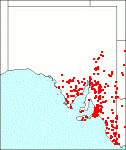Family: Asteraceae
Senecio quadridentatus
Citation:
Labill., Nov. Holl. Pl. Sp. 2:48, t. 194 (1806).
Synonymy: Erechtites quadridentata Common name: Cotton fireweed, fireweed.
Description:
Erect or ascending perennial herb, 40-100 cm high, white-cottony throughout or distally glabrescent, much-branched from the base, 40-100 cm high; leaves linear to narrowly lanceolate, 5-10 rarely 15 x0.4-1.5 cm, acute, often denticulate but usually strongly revolute and appearing entire, occasionally with one or more exserted coarse teeth near the base, densely cottony-haired beneath, more sparsely hairy above, or occasionally glabresent.
Inflorescence initially congested, becoming laxly corymbose-paniculate, of 60-400 heads; peduncles 7-14 mm long; involucres slenderly cylindrical, 7.5-10 x 2-3 mm, flask-shaped and often spiralled in bud; bracts 10-13; calyculus of 1-4 bracteoles; female florets 20-30, 3- or 4-lobed; bisexual florets 4-10, 4- or rarely 5-lobed.
Achene tapering and slightly knobby basally, attenuate-rostrate apically, 2.5-3 rarely 4 mm long, olive-green, reddish, or dark-brown, hairy in the narrow grooves between the prominent ribs; pappus deciduous, dimorphic.
Published illustration:
Cunningham et al. (1982) Plants of western New South Wales, p. 679.
|
|
Distribution:
|
In disturbed situations in grasslands, shrublands, and open woodlands, especially after fire, not persisting in closed forests except along the roadsides; found on a great diversity of soils.
S.Aust.: LE, FR, EA, EP, NL, MU, YP, SL, KI, SE. All States. New Zealand, New Caledonia and Timor.
|
Conservation status:
native
Flowering time: Oct. — March.
|

SA Distribution Map based
on current data relating to
specimens held in the
State Herbarium of South Australia
|
Biology:
The most common and widely distributed of the erechthitoid species. May become a weed, especially in pastures, and is regarded as toxic to livestock although not usually eaten.
Taxonomic notes:
Positively distinguished from S. tenuiflorus by characters of the achenes and by the involucral bracts typically each with 3 prominent veins and 1-4 minor ones (visible only after use of a clearing agent such as lactic acid).
Author:
Not yet available
|

